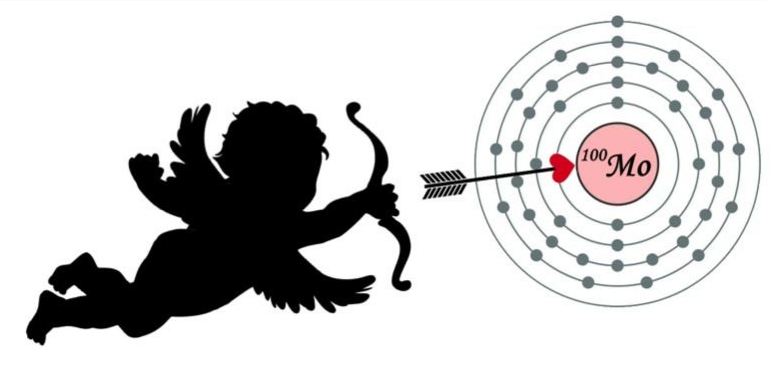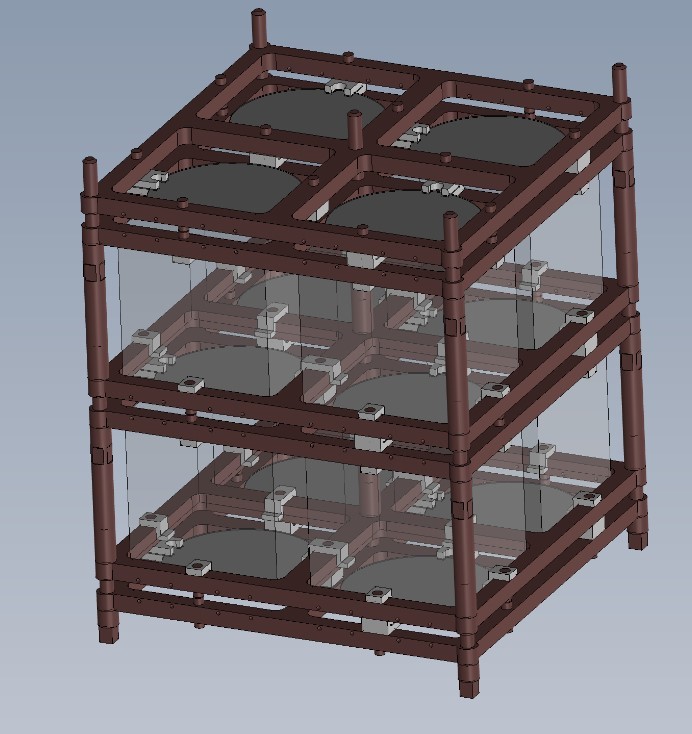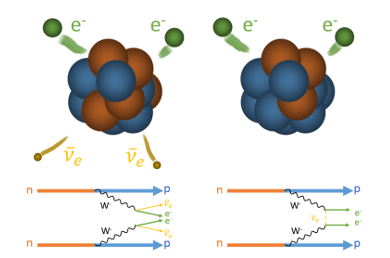
On the left the 2νββ (double beta decay with antineutrino emission), on the right the 0νββ (neutrinoless double beta decay) and their respective Feynman diagrams.
The search for double beta decay without neutrino emission (0νββ) is one of the major challenges of contemporary physics, because its observation would make a clear statement about the nature of the neutrino itself and potentially on the origin of the matter/antimatter asymmetry of our universe. The CUPID collaboration, in which several researchers from IRFU and IN2P3 are involved, is actively researching this process using scintillating bolometers as detectors. In June 2020, the CUPID-Mo demonstrator experiment, which is located at the Modane underground laboratory, demonstrated the excellent potential of this detection method with only 2.264 kg of 100Mo and one year of data collection. In the coming years, the objective of the CUPID collaboration is to design one of the most sensitive experiments ever built by increasing the total mass of 100Mo to 250 kg. Three articles have just been published on the technological and methodological choices needed for this change of scale, while maintaining the required performances of the final experiment.
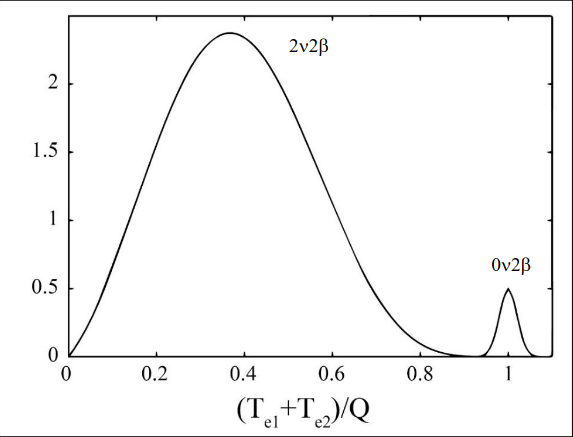
Figure 2: spectrum of the sum of the energies of the two emitted electrons. In the case of 0νββ a peak at the transition energy Q is expected.
More mass for better chances...
From an experimental point of view, it would be sufficient to observe a peak at the 0νββ decay energy in the spectrum of emitted electrons to demonstrate its existence (see figure 2). For this, the CUPID collaboration uses the so-called "bolometric" detection technique, i.e. using a scintillating crystal composed of an isotope capable of realizing the 0νββ which, when a nuclear decay occurs inside the crystal, heats it up very slightly and produces light. The temperature rise, related to the energy of the event, is then measured by an ultra-sensitive thermometer (NTD) stuck on one face of the crystal while the light is collected by a light detector placed above or below the crystal, and is used to identify α background events. However, the extreme rarity of the 0νββ process (whose rate, currently constrained by previous experiments, is less than a few decays per kilogram of detector and per year) makes it a considerable challenge and therefore requires to be able to suppress the backgrounds down to negligible levels. Increasing the exposure time of the detector and its total mass increases the number of potential 0νββ decays, and thus the intensity of the peak sought and thus the chances of observing it. This is why the CUPID experiment aims to build in the years to come a detector at the ton scale (including 250 kg of isotope) by using more than a thousand scintillating crystals of Li2MoO4, enriched with 100Mo. However, this implies a considerable technological and methodological endeavour to ensure that such a detector will have the same performances as its small-scale version. This technological development is the subject of various so-called demonstrator experiments, as was CUPID-Mo which has already obtained very encouraging results, validating the Li2MoO4 scintillating crystals as excellent detectors for the search for decay 0νββ.
Cubic rather than cylindrical crystals
Instead of cylindrical crystals like those used in CUPID-Mo, cubic crystals of Li2MoO4 are now being studied, as they allow to realize more compact structures (like the towers of the CUORE experiment, the big sister of CUPID, using cubic crystals of TeO2). Two demonstrator experiments delivered their results in November about this subject:
- One took place at LNGS (Laboratori Nazionali del Gran Sasso, Italy) and studied a structure composed of 8 cubic crystals (figure 3) and the effect of a reflective film surrounding half of them on the amount of scintillation light collected by the light detectors [1].

Figure 4: bolometer used in the CROSS cryostat with the different elements composing it. On this picture, the light detector is not present.
- The second took place in the experimental set-up of the CROSS experiment at the LSC (Laboratorio Subterráneo de Canfranc, Spain) whose cryostat has the advantage of using the same technology used in the CUORE experiment (which is supposed to host the CUPID experiment in fine), and thus to approach the experimental conditions of the future experiment [2].
These two studies confirmed the excellent performance of cubic Li2MoO4 crystals, with an energy resolution between 6 and 7 keV in the 100Mo region of interest, approaching the 5 keV objective set by the CUPID collaboration! In addition, a total rejection of the events due to α particles is ensured with or without reflective film. The compatibility of these results with those of CUPID-Mo therefore validated the possibility of using this bolometer geometry for the CUPID experiment.
A new method to study signal pile-ups
Bolometers are relatively slow detectors. That is to say, it can take several hundred ms for the crystal to return to its thermal equilibrium when an event occurs inside. This implies that if two events occur in a too short a period of time for their signals to be separated, they are then confused into a single signal with erroneous energy that may fall into the region of interest. This phenomenon, although still very rare, is one of CUPID's major challenge in achieving an ever-lower background noise level, since the 100Mo isotope has the shortest half-life of 2νββ of all the nuclei that can achieve it (T1/22νββ=7.1 x 1018 years), thus multiplying the signals in the detector and the chances of pile-up. In order to study the contribution of this process to the background noise as well as the discriminating power of these events, a new method has been developed, using a resistive element (called "heater") glued on one face of a Li2MoO4 crystal (figure 4) which injects signal pile-ups with a shape very close to that of a 2νββ event (figure 5). By varying their time deviation as well as their amplitude, their study allowed to identify parameters related to the shape of the signal in order to reject the pile-ups with an efficiency higher than 90% if the two signals arrive in a time window longer than 2 ms [3]. This method has the advantage of studying the phenomenon directly through the response of the detector, unlike simulations, and is therefore a promising way to study other parameters and improve its rejection power, and thus meet the background rejection goals required by CUPID: rejecting the pile-ups beyond 1 ms.
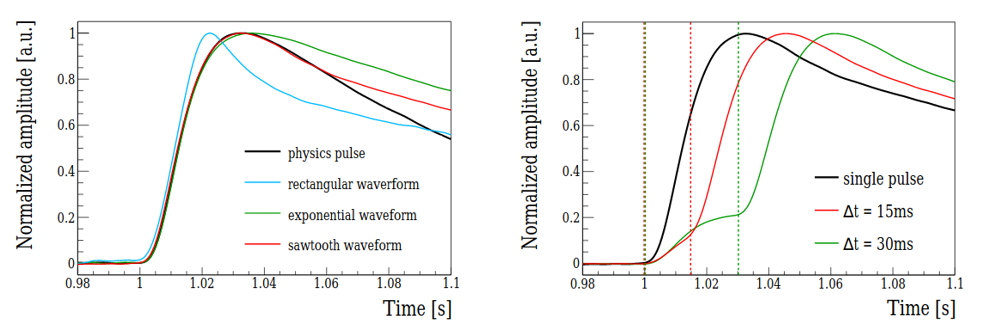
Figure 5: On the left, the detector response for the different forms of injected signals. A signal injected with a sawtooth shape (red curve) gives the response closest to the shape of a real signal (black curve). On the right, the difference in shape between a single signal and a pile-up of two signals separated by 15 ms and 30 ms.
In the coming months, CUPID will continue its transition to a ton-scale experiment by testing, for example, a new assembly strategy for the detectors and a new tower configuration at LNGS, promising further encouraging advances in 2021 and new discovery opportunities for the collaboration.
The year 2020 was thus rich in results for the CUPID collaboration with three articles that you can find in pre-published version here:
- [1] Characterization of cubic Li2MoO4 crystals for the CUPID experiment: https://arxiv.org/abs/2011.13656
- [2] A CUPID Li2MoO4 scintillating bolometer tested in the CROSS underground facility: https://arxiv.org/abs/2011.13806
- [3] A novel technique for the study of pile-up events in cryogenic bolometers: https://arxiv.org/abs/2011.11726
as well as the previous highlight on the results of CUPID-Mo: http://irfu.cea.fr/en/Phocea/Vie_des_labos/Ast/ast.php?t=fait_marquant&id_ast=4800
and all the previous highlights: http://irfu.cea.fr/en/Phocea/Vie_des_labos/Ast/ast_technique.php?id_ast=3901&voir=fm
Contacts: Claudia Nones, Antoine Armatol
• The ultimate constituents of matter
• Institute of Research into the Fundamental Laws of the Universe • The Electronics, Detectors and Computing Division • The Particle Physics Division
• Sources and reactors neutrinos
• LUMINEU

